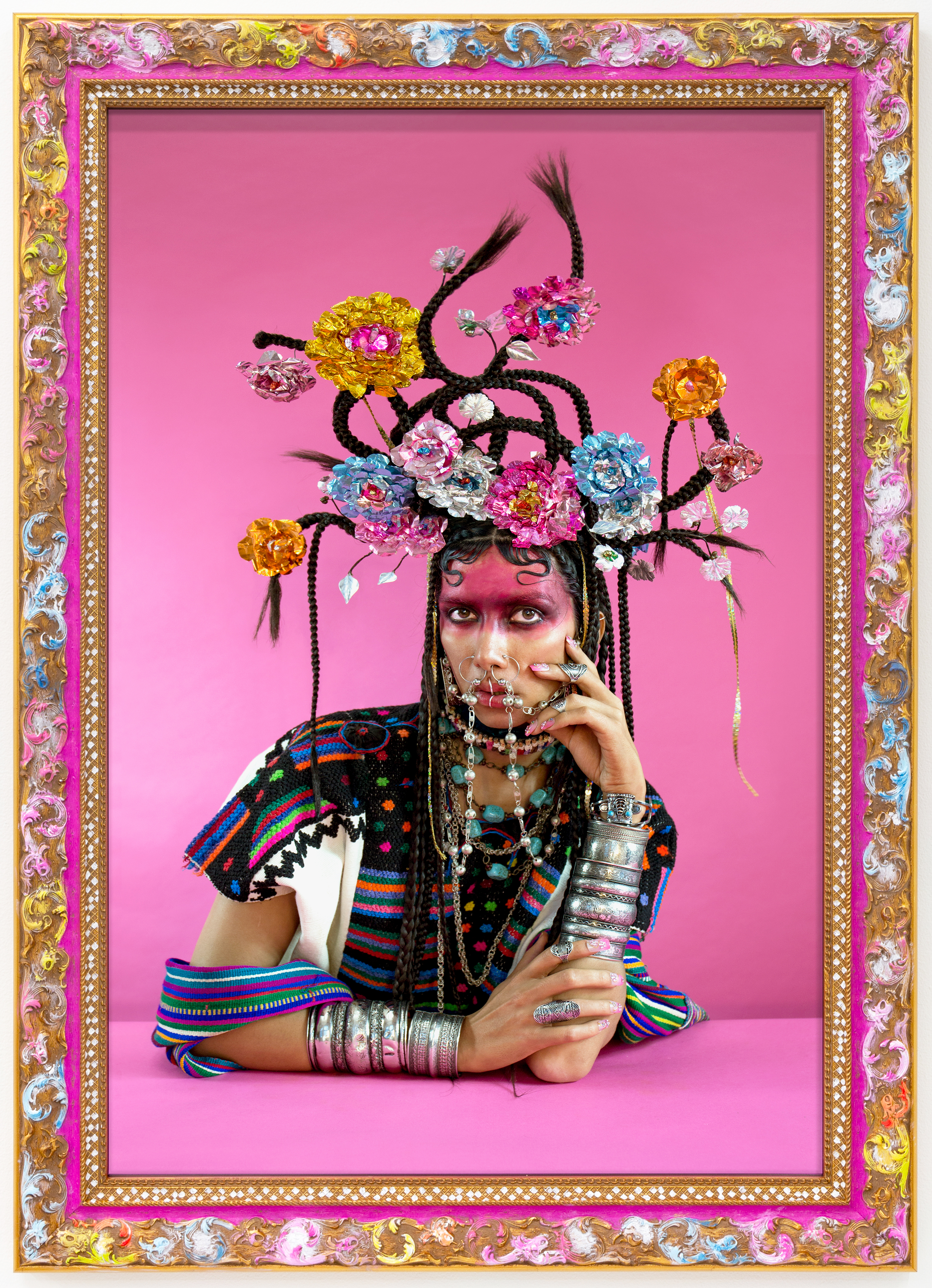
Martine Gutierrez. Demons, Xochipilli ‘The Flower Prince,’ p91 from Indigenous Woman, 2018. C-print mounted on Sintra. 36 x 24 inches (91.4 x 61 cm). Edition 1 of 8. Courtesy of the Artist and RYAN LEE Gallery, New York.
Rainbows of Guatemalan textiles, tassels, and pom-poms dangle from Martine Gutierrez, posing as a fantasy rendition of the Aztec goddess Xochiquetzal in her publication, Indigenous Woman. This image, from Gutierrez’s “Demons” series, subtitled “Deities of the Ancient World Resurrected in Hair,” is one of the many glamazon archetypes the artist embodies throughout the magazine. Xochiquetzal, a patroness of artists, lovers, and all things pleasurable, and Tlazolteotl (“Eater of Filth”), known to incite vice and purification, are Aztec deities in the series that manifests opposing concepts of duality and genderfluidity. “I was looking for iconography that celebrated bodies outside of the binary—deities even bigger than bodies—because in general we tend to see ourselves in a god’s image, whatever god that may be,” Gutierrez explained. And just as divinities from the Aztec pantheon encompassed a myriad of aptitudes, so does Gutierrez, as the creative director, model, and photographer of Indigenous Woman, an art magazine that uses advertising language to deconstruct out-of-date ideas about ethnic and sexual identity.

Martine Gutierrez. Indigenous Woman (front cover), 2018. Artist magazine, off-set printed; 124 pages. 16 1/2 x 11 inches (41.9 x 27.9 cm). Courtesy of the Artist and RYAN LEE Gallery, New York.
The publication performs well as a traditional beauty magazine, complete with a collection of fashion editorials, hair and beauty features, and a plethora of advertisements. A passive observer may mistake it as another glossy monthly, but under its glamorous surface and high production quality lurks a humorous critique about the exotification of identity. Satirical beauty ads like “COVERTGIRL,” underscored with the catchphrase, “Maybe she’s born with it. Maybe it’s white privilege,” and an editorial for lavish mask routines containing ingredients like “Japanese algae, Eastern oysters, and Chinese freshwater pearls” mimic the content that fills most trendy women’s periodicals. About making the magazine, Gutierrez said, “I am pioneering an image that is to be consumed and engineered to be read as commercial. I had to study the visual language of advertising.”

Martine Gutierrez. Indigenous Woman (back cover), 2018. Artist magazine, off-set printed; 124 pages. 16 1/2 x 11 inches (41.9 x 27.9 cm). Courtesy of the Artist and RYAN LEE Gallery, New York.
“Why do we want to be this person or this brand?” —Martine Gutierrez
“This is not a magazine about fashion, lifestyle, or celebrity,” Gutierrez states in the Indigenous Woman letter from the editor. “Fashion is a good veneer for making people look at what otherwise might make them feel uncomfortable.” Gutierrez’s love of fashion, pop culture, and pageantry is clear, which reveals itself in her muse; “I just feel like a scam in terms of [my] references.” When asked where she seeks inspiration, she says, “I’m looking at people like Kim Kardashian. I’m looking at everything that becomes cool and at why we’re obsessed with it: Why do we want to be this person or this brand?”
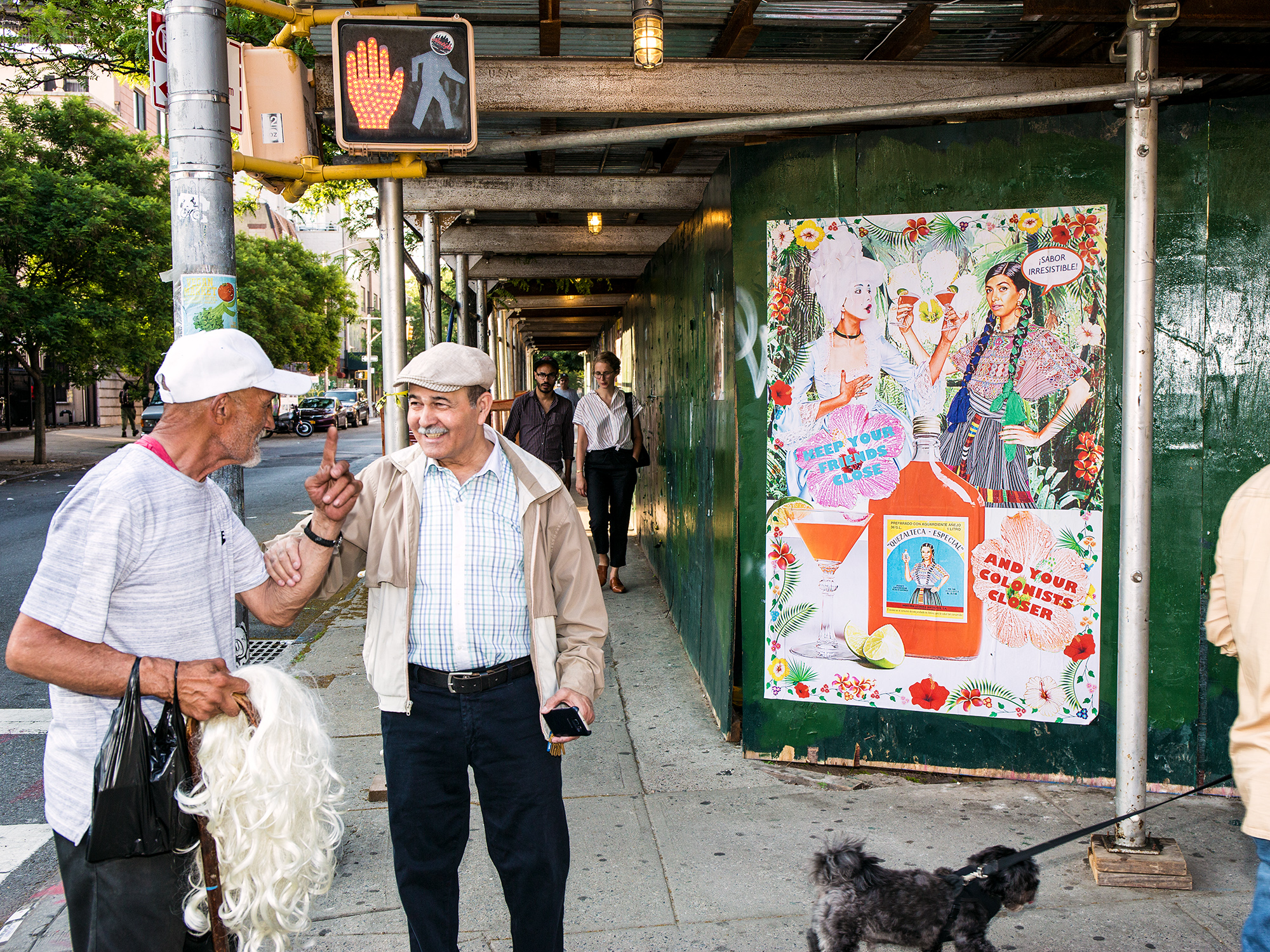
Martine Gutierrez. Quezalteca Especial Ad, p40-41 from Indigenous Woman, 2018. C-print mounted on Sintra. 54 x 72 inches (137.2 x 182.9 cm). Edition of 8. Courtesy of the Artist and RYAN LEE Gallery, New York.
During the four years of working to develop the publication—which blossomed into a solo exhibition—Gutierrez underwent “constant introspection and reflection”: interrogating her image, cultural background, and identity; centering herself as the subject for Indigenous Woman. In the demon-goddess portraits, Gutierrez adorns herself with golden jewelry, beaded masks, and towering braided crowns, extending her expression of identity beyond the human realm. The Aztec heroines Xochiquetzal and Tlazolteotl, the Mayan goddess Chin, and the Yoruba orisha Yemaya were inspiring to Gutierrez, as entities “who sit in a temple built to protect me and dolls like me.” Other personifications in Indigenous Woman—such as the Neo Indeo supermodels, allegories of the artist’s preteen queer rage, and a cleaning lady in soap ads—also explore iterations of identities that have been pressed upon Gutierrez throughout her life. At its core, Indigenous Woman is an editorial look book of dramatized personal identity in conversation with stereotypes the artist has experienced.
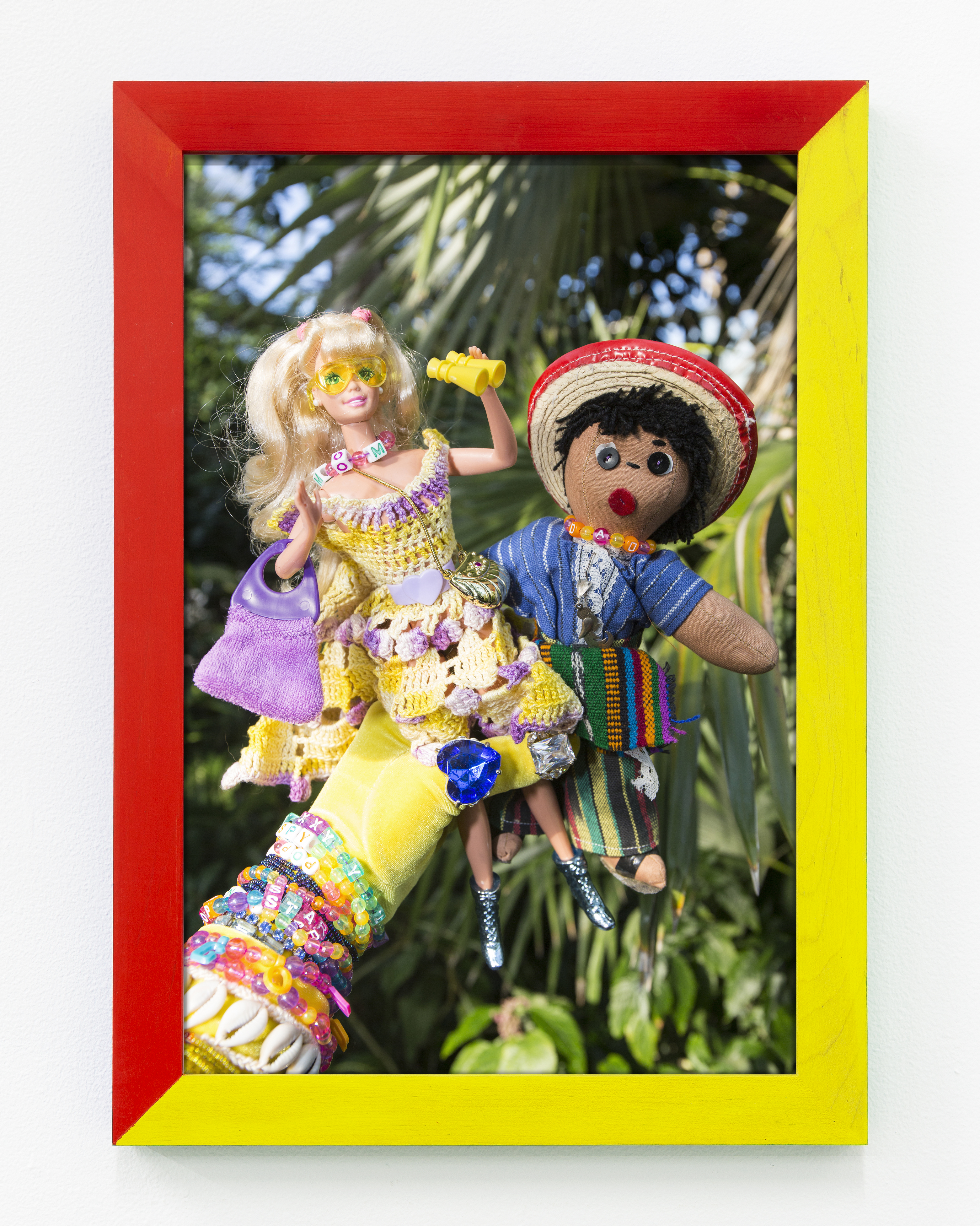
Martine Gutierrez. Queer Rage, P.S. Your Parents Are Nuts, p73 from Indigenous Woman, 2018. C-print mounted on Sintra with hand-painted artist frame. 16 1/2 x 11 inches (41.9 x 27.9 cm). Edition of 8. Courtesy of the Artist and RYAN LEE Gallery, New York.
It’s reframing indigenous identity beyond the typical tropes of nostalgia, poverty, and antiquity.
“Language never seemed like a way to clarify who I was. I was afraid of getting roped into a category or being pigeon-holed,” Gutierrez says. The art, fashion, and media worlds use terms like Latinx, indigenous, trans, queer, and bi-racial to describe her, but these labels often function as reductive shorthand for a range of experiences. Gutierrez’s self-examination came full force after the racialization she experienced when she moved across the country, from California to Vermont, during high school. Her blended ancestry—she has a white, American mother from upstate New York and a Guatemalan father—and her being trans were never seen as strange in Oakland, where many of her peers were from mixed-race, same-sex, multireligion, cosmopolitan households. “It was jarring because [in Vermont] everyone asked the age-old questions: ‘Where are you from?’ ‘What are you?’ I didn’t know how to answer them—I’m so many things.”
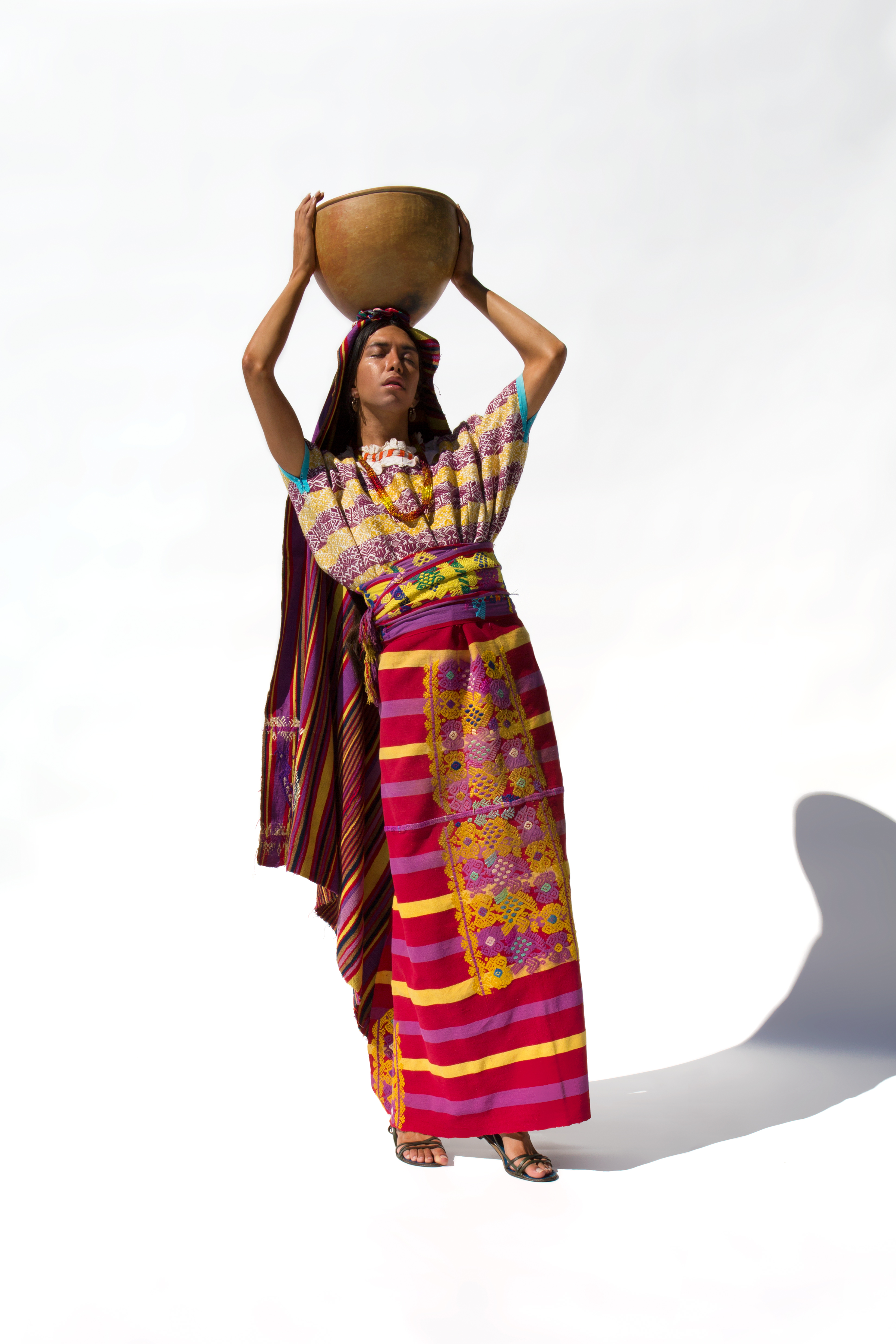
Martine Gutierrez. Neo-Indeo, Cakchiquel Calor, p34 from Indigenous Woman, 2018. C-print mounted on Sintra. 54 x 36 inches (137.2 x 91.4 cm). Edition of 8. Courtesy of the Artist and RYAN LEE Gallery, New York.
In Indigenous Woman, Gutierrez pays homage to her heritage with editorials featuring characters from the Mayan communities of Cakchquel, Chuj, and Kekchí. Modeling Guatemalan textiles sourced from her family’s collection, fashioned into “a modern collection of traditional Mayan trajes de Guatemala,” she illustrates “a contemporary living history, not one that is just buried.” The fashion industry often appropriates indigenous culture through its design but rarely credits the source, and some designers even claim credit. “Neo Indeo” functions as a commentary on the invisibility of living indigenous craftsmanship and the appropriation that designers often perpetrate. It’s reframing indigenous identity beyond the typical tropes of nostalgia, poverty, and antiquity. “This is how your abuelita might dress, but this is also how her granddaughter is going to dress,” Gutierrez explained.
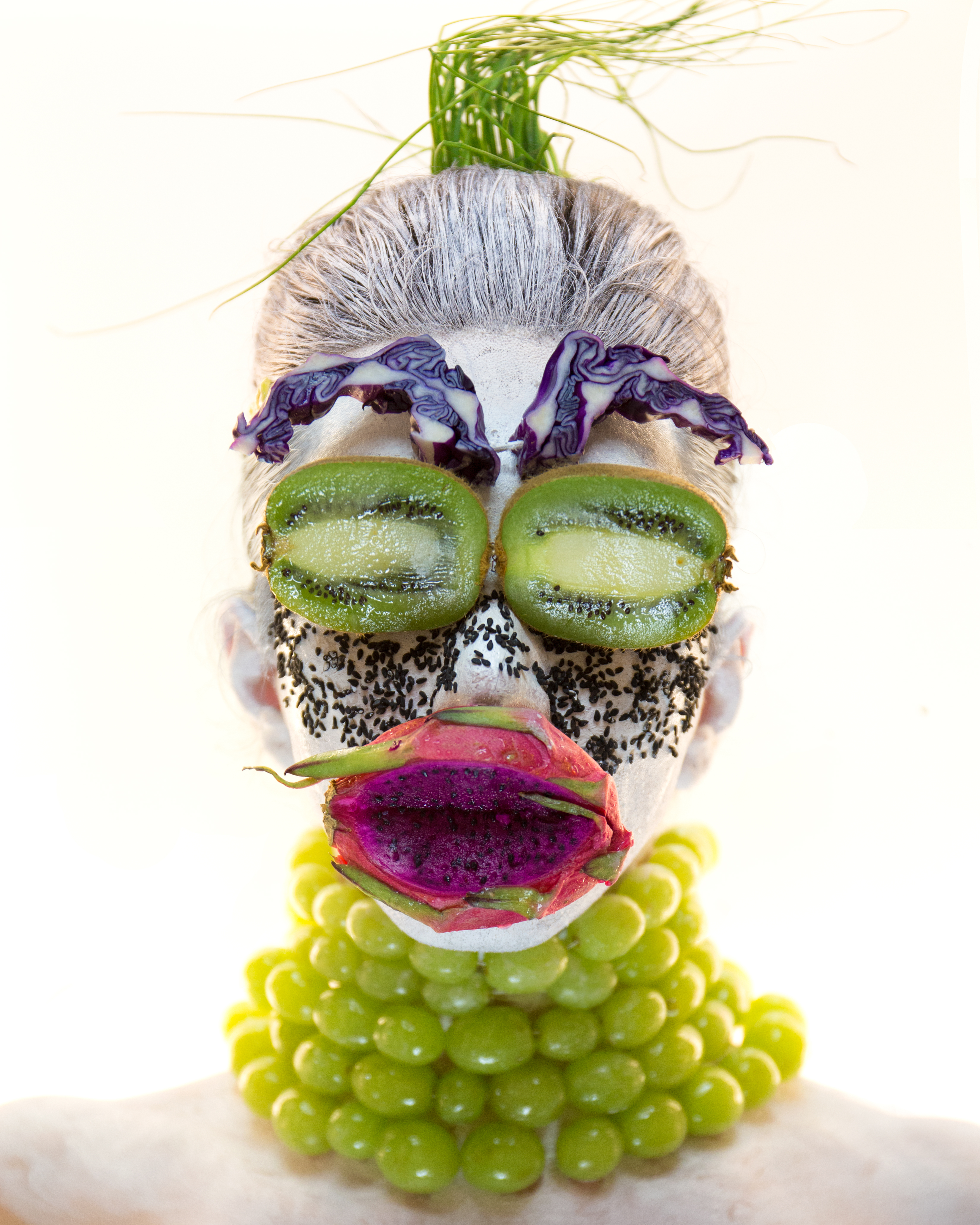
Martine Gutierrez. Masking, Green-Grape Mask, p51 from Indigenous Woman, 2018. C-print mounted on Sintra. 20 x 16 inches (50.8 x 40.6 cm). Edition of 8. Courtesy of the Artist and RYAN LEE Gallery, New York.
From makeup and beauty advertisements to gallery walls, queer artists are more visible now than ever, but who is driving the narrative? Gutierrez says, “It’s very cool to be brown, and it’s really cool to be trans, right now.” Her satirical “Masking” series shows extravagant stylizations of invented beauty rituals, prefaced by the editorial statement: “True beauty is not something we conform to but [rather] a practice of health and self-care that celebrates our complete uniqueness and individuality.” GreenGrape Mask (2018), shows Gutierrez’s face painted white with a jasmine-rice paste, with halved kiwi fruits placed on her eyelids, a dragonfruit in her mouth, cabbage covering her eyebrows, and a necklace of Chilean seedless green grapes. The list of luxurious ingredients needed for these facials is Gutierrez’s humorous way of questioning the commodification and exotification of indigenous practices, akin to the absurdity of doing ayahuasca ceremonies in Brooklyn yoga studios.
Asked about the critical response to the exhibition, Gutierrez said it’s been overwhelmingly positive, with the caveat that “people are afraid to give criticism to a trans woman or a person of color within a formal setting because they don’t want to be seen as transphobic or racist or generally not woke.” She says most people don’t even want to talk about the publication: “All people want to do is talk about my identity—the qualifiers that make me a minority—and not that I published and executed a 120-page magazine by myself.” And though the title Indigenous Woman is made up of identity designations, Gutierrez’s shapeshifting subjects destroy commonly held beliefs about what an indigenous woman can signify. The artist concludes, “In my mind, labels are so divisional. We just need more people being, like, ‘This is my life.’”



